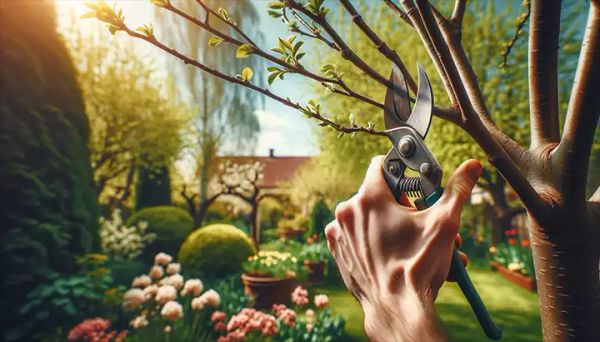Pruning is an important part of gardening that helps maintain the health and structure of trees and shrubs. It may seem like a complex task, but with some knowledge and practice, anyone can master the art of pruning.

Understanding Growth Buds
When it comes to pruning, it’s crucial to understand the growth buds of plants. One key concept is apical dominance, which means that plants primarily grow from the terminal or apex bud, suppressing the growth of lateral buds. This dominance varies across species and affects the number and length of lateral shoots.
The orientation of limbs also plays a role in growth patterns. Vertical limbs have strong apical dominance, resulting in vigorous growth near the terminal bud. Lateral branches at 45° to 60° angles see reduced apical dominance, leading to more lateral growth. Horizontal limbs, on the other hand, lose apical dominance entirely, often resulting in the growth of water sprouts.

Removing Heavy Branches
When it comes to removing heavy branches, there are a few steps you should follow:
- Cut from below: Start by making an undercut to prevent the bark from tearing.
- Cut the branch top: Make a top cut outside the first cut to remove the branch.
- Cut to the branch collar: Finalize the process by cutting close to the branch collar without damaging it. This ensures optimal healing.
General Pruning Process
Timing is crucial when it comes to pruning. It’s generally best to prune during dormancy in winter or early spring. However, there are some exceptions:
- Flowering shrubs: Prune them after they bloom to avoid cutting off next season’s buds.
- Evergreens and fruit trees: Prune evergreens in early spring, while fruit trees benefit from pruning to open up the crown for better light penetration and fruit production.
- Roses: Prune roses in spring by cutting back to healthy, live wood just above an outward-facing bud.
Pruning Techniques
Different pruning techniques can help you achieve specific goals for your plants. Here are a few common techniques:
- Thinning: This technique involves removing entire shoots from their origin, maintaining apical dominance and encouraging growth at undisturbed shoot tips.
- Water sprouts and suckers: Removing water sprouts and suckers helps prevent energy drain and guides growth.
- Renewal pruning: This technique aims to improve air circulation and light penetration. Older trees especially benefit from pruning to stimulate new growth.
- Crotches and angles: It’s important to remove limbs with narrow-angled crotches as they tend to be weaker and more prone to damage.
Healing and Regrowth
Pruning triggers the healing process in the cambium layer of a plant. To ensure faster healing, it’s important to prune close to the main branch without injuring the bark ridge or branch collar. Pruning also stimulates regrowth near the cut, with more severe pruning resulting in greater regrowth as the plant tries to restore balance between the top and the root system.
In conclusion, pruning trees and shrubs is not just about cutting back growth. It’s a skill that requires understanding the biology of plants and their growth patterns. Proper pruning not only encourages healthy growth but also enhances the plant’s aesthetic appeal while preventing diseases and damage. So grab your pruning tools and let your plants thrive!
Inspired by this? Share the article with your friends!



